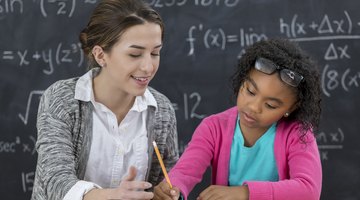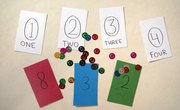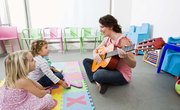Jean Piaget was a forefather of modern child development theory. Surprisingly, this educational academic began his career in the natural sciences. A quick turn to psychoanalysis brought an interest in human learning and knowledge acquisition. Piaget's stages of cognitive development encompass growth from birth through adolescence. They include what he termed the sensorimotor stage (birth to 2 years), the preoperational stage (approximately 2 through 7), he concrete stage (7 through early adolescence), and the formal operational stage (adolescence). Educators can use the developmental theories behind each stage to create age-graded strategies for teaching mathematics.
Preoperational Stage
Acquire an accurate description of Piaget's theory of preoperational development for children from approximately age 2 through first grade. In general, children in this stage are beginning to understand how symbols (such as words or numbers) can represent objects, use make-believe or fantasy thought, are fairly egocentric in thinking, and do not have a firm grasp on the concept of time.
Choose specific aspects of Piaget's preoperational theory that match mathematics teaching for your age group/grade. Include concepts that easily translate into teaching strategies. For example, use the idea that the child now might understand the connection between an object and the symbol that it represents. Set up a hands-on number lesson in which groups of toys or other objects represent numbers such as five toy cars, three apples, or seven pieces of chalk.
Write your lesson plan detailing each step and its relation to Piaget's theory. Note the specific stage (i.e., preoperational) and theory idea (e.g., make-believe/fantasy, representation). Design a specific learning goal or object, such as students learning to count to 10 by themselves, or child recognizing written numerals. Make a bulleted list of materials and a numbered list of steps.
Concrete Operational Stage
Understand Piaget's concrete operational stage. Children in this stage (roughly 7 through early adolescence) can consider multiple dimensions or aspects of a single object, understand seriation (ordering objects by increasing or decreasing values), and are able to classify objects. Concrete examples and hands-on experiences are essential to learning during this stage of development.
Create a lesson plan based on the ideas Piaget theorized about in this developmental stage. Develop learning objectives/goals, such as the students learning the multiplication tables through nine, or the students demonstrating knowledge of place value.
Make a written list of materials needed. Because this stage often demands the use of concrete materials, try items such as pattern blocks, math tiles or counter beads. Write lesson steps, connecting each significant part to a key Piaget idea (e.g., conservation, seriation, classification).
Set up hands-on mathematics explorations in the classroom to accompany the lessons. For example, if you are teaching multiplication tables to grade-schoolers, use small math tiles (or other similar objects) on a board to connect the numbers and representations. Allow the students to work out the solutions on their own with guidance only as needed.
Formal Operational Stage
Learn about and understand the formal operational stage (typically the adolescent period). Students in this stage are capable of creating their own hypothesis, thinking about consequences, use abstract thinking and reasoning, making inferences, evaluating ideas, and applying one concept to another.
Choose specific concepts of Piaget's theory to connect to math. Try applying pre-existing knowledge to the math world through well-crafted word problems, providing multiple pieces of information for the students to clarify and deduce answers from, or using problems that require reasoning skills. Students in this stage should be able to understand algebraic concepts, and lessons can include the use of variables.
Write a lesson plan. Include a materials list as needed and a numbered step list. Note specific components that tie to Piaget's ideas with vocabulary such as clarification, evaluation, application or inference.
Tip
Children in the preoperational stage are beginning to group objects by characteristics. Try a simple geometry lesson, asking students to choose like and different qualities of shapes.
Blend Piaget's theory of development with other educational/child development theories for an all-encompassing mathematics curriculum.
Warning
Before the concrete stage of development, children might not be able to understand the concept of conservation. With these children, avoid overemphasizing subjects such as measurement.
Children in the sensorimotor stage, infants, might not be able to learn math concepts through traditional lessons.
Not all learners are the same. Although a student is supposed to fit into a certain stage based on age, individual abilities might place a child in a higher or lower category.
Related Articles
References
Tips
- Children in the preoperational stage are beginning to group objects by characteristics. Try a simple geometry lesson, asking students to choose like and different qualities of shapes.
- Blend Piaget's theory of development with other educational/child development theories for an all-encompassing mathematics curriculum.
Warnings
- Before the concrete stage of development, children might not be able to understand the concept of conservation. With these children, avoid overemphasizing subjects such as measurement.
- Children in the sensorimotor stage, infants, might not be able to learn math concepts through traditional lessons.
- Not all learners are the same. Although a student is supposed to fit into a certain stage based on age, individual abilities might place a child in a higher or lower category.
Writer Bio
Based in Pittsburgh, Erica Loop has been writing education, child development and parenting articles since 2009. Her articles have appeared in "Pittsburgh Parent Magazine" and the website PBS Parents. She has a Master of Science in applied developmental psychology from the University of Pittsburgh's School of Education.











